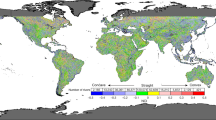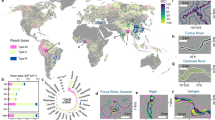Abstract
River networks are striking features engraved into the surface of the Earth, shaped by uplift and erosion under the joint influence of climate and tectonics. How a river’s gradient changes as it descends along its course—its longitudinal profile concavity—varies greatly from one basin to the next, reflecting the interplay between uplift and erosional processes. A recent global analysis has suggested that climatic aridity should be a first-order control on river profile concavity, but the importance of climate relative to other factors has not been tested at global scale. Here, we show, using recent global datasets of climate, river profiles and tectonic activity, that tectonics is much more strongly expressed than climate in global patterns of river profile concavity. River profiles tend to be more strongly concave in tectonically active regions along plate boundaries, reflecting tectonically induced spatial variations in uplift rates. Rank correlations between river profile concavity and four global tectonic proxies (basin-averaged channel gradients, distance to plate boundaries and two measures of seismic activity) are much stronger than those between river concavity and three climate metrics (precipitation, potential evapotranspiration and aridity). We explain the association between tectonic activity and increased river profile concavity through a simple conceptual model of long-term uplift and river incision. These results show that tectonics, and not climate, exerts dominant control on the shape of river longitudinal profiles globally.
This is a preview of subscription content, access via your institution
Access options
Access Nature and 54 other Nature Portfolio journals
Get Nature+, our best-value online-access subscription
$29.99 / 30 days
cancel any time
Subscribe to this journal
Receive 12 print issues and online access
$259.00 per year
only $21.58 per issue
Buy this article
- Purchase on Springer Link
- Instant access to full article PDF
Prices may be subject to local taxes which are calculated during checkout




Similar content being viewed by others
Data availability
All data used in this study are available in the Supplementary Information or via the cited sources. The model outputs that support the findings of this study are available in Supplementary Table 1. NCI, aridity and slope data are available at https://doi.org/10.17636/010581627. Precipitation data22 are available at https://www.worldclim.org/data/v1.4/worldclim14.html. Potential evapotranspiration data23 are available at https://cgiarcsi.community/data/global-aridity-and-pet-database/. Plate boundary data24 are available at https://github.com/fraxen/tectonicplates. HydroSHEDS data25 are available at https://www.hydrosheds.org. GEM data20 are available at https://www.globalquakemodel.org. GSHAP data21 are available at https://www.gfz-potsdam.de/en/GSHAP. Source data are provided with this paper.
Code availability
The numerical code we used to analyse the data is available upon request.
Change history
15 July 2021
A Correction to this paper has been published: https://doi.org/10.1038/s41561-021-00810-4
References
Howard, A. D. A detachment‐limited model of drainage basin evolution. Water Resour. Res. 30, 2261–2285 (1994).
Willett, S. D., McCoy, S. W., Perron, J. T., Goren, L. & Chen, C. Y. Dynamic reorganization of river basins. Science 343, 1248765 (2014).
Vannote, R. L., Minshall, G. W., Cummins, K. W., Sedell, J. R. & Cushing, C. E. The river continuum concept. Can. J. Fish. Aquat. Sci. 37, 130–137 (1980).
Smith, L. C. Rivers of Power: How a Natural Force Raised Kingdoms, Destroyed Civilizations and Shapes Our World (Little, Brown and Company, 2020)
Hack, J. T. Studies of Longitudinal Stream Profiles in Virginia and Maryland Geological Survey Professional Paper 294-B (USGS, 1957).
Seybold, H., Rothman, D. H. & Kirchner, J. W. Climate’s watermark in the geometry of stream networks. Geophys. Res. Lett. 44, 2272–2280 (2017).
Chen, S. A., Michaelides, K., Grieve, S. W. & Singer, M. B. Aridity is expressed in river topography globally. Nature 573, 573–577 (2019).
Gilbert, G. K. Report on the Geology of the Henry Mountains (USGS, 1877).
Leopold, L. B. & Maddock, T. Jr The Hydraulic Geometry of Stream Channels and Some Physiographic Implications Geological Survey Professional Paper 252 (USGS, 1953).
Montgomery, D. R. & Buffington, J. M. Channel-reach morphology in mountain drainage basins. Geol. Soc. Am. Bull. 109, 596–611 (1997).
Whipple, K. X. & Tucker, G. E. Dynamics of the stream-power river incision model: implications for height limits of mountain ranges, landscape response time scales and research needs. J. Geophys. Res. 104, 17661–17674 (1999).
Sklar, L. & Dietrich, W. E. in Rivers over Rock: Fluvial Processes in Bedrock Channels (eds Tinkler, E. J. & Wohl, E. E.) 237–260 (American Geophysical Union, 1998).
Whittaker, A. C., Attal, M., Cowie, P. A., Tucker, G. E. & Roberts, G. Decoding temporal and spatial patterns of fault uplift using transient river long profiles. Geomorphology 100, 506–526 (2008).
Ferrier, K. L., Huppert, K. L. & Perron, J. T. Climatic control of bedrock river incision. Nature 496, 206–209 (2013).
Kirby, E. & Whipple, K. X. Expression of active tectonics in erosional landscapes. J. Struct. Geol. 44, 54–75 (2012).
DiBiase, R. A., Whipple, K. X., Heimsath, A. M. & Ouimet, W. B. Landscape form and millennial erosion rates in the San Gabriel Mountains, CA. Earth Planet. Sci. Lett. 289, 134–144 (2010).
Demoulin, A. Testing the tectonic significance of some parameters of longitudinal river profiles: the case of the Ardenne (Belgium, NW Europe). Geomorphology 24, 189–208 (1998).
Pritchard, D., Roberts, G. G., White, N. J. & Richardson, C. N. Uplift histories from river profiles. Geophys. Res. Lett. 36, L24301 (2009).
Gallen, S. F. & Wegmann, K. W. River profile response to normal fault growth and linkage: an example from the Hellenic forearc of south-central Crete, Greece. Earth Surf. Dyn. 5, 161–186 (2017).
Pagani, M. et al. The 2018 version of the Global Earthquake Model: hazard component. Earthq. Spectra https://doi.org/10.1177/8755293020931866 (2020).
Giardini, D., Grünthal, G., Shedlock, K. M. & Zhang, P. The GSHAP global seismic hazard map. Ann. Geophys. 42, 1225–1230 (1999).
Fick, S. E. & Hijmans, R. J. WorldClim 2: new 1-km spatial resolution climate surfaces for global land areas. Int. J. Climatol. 37, 4302–4315 (2017).
Trabucco, A. & Zomer, R. J. Global Aridity and PET Database (CGIAR Consortium for Spatial Information, 2009); https://cgiarcsi.community/data/global-aridity-and-pet-database/
Bird, P. An updated digital model of plate boundaries. Geochem. Geophys. Geosyst. 4, 1027 (2003).
Lehner, B., Verdin, K. & Jarvis, A. HydroSHEDS Technical Documentation, Version 1.0 (World Wildlife Fund, 2006).
Burbank D. W. & Anderson R. S. Tectonic Geomorphology 2nd edn, 316–369 (Blackwell Science, 2012)
Montgomery, D. R. & Brandon, M. T. Topographic controls on erosion rates in tectonically active mountain ranges. Earth Planet. Sci. Lett. 201, 481–489 (2002).
Montgomery, D. R. Slope distributions, threshold hillslopes and steady-state topography. Am. J. Sci. 301, 432–454 (2001).
Roe, G. H., Montgomery, D. R. & Hallet, B. Effects of orographic precipitation variations on the concavity of steady-state river profiles. Geology 30, 143–146 (2002).
Anderson, R. S., Molnar, P. & Kessler, M. A. Features of glacial valley profiles simply explained. J. Geophys. Res. 111, F01004 (2006).
Sklar, L. S. & Dietrich, W. E. Implications of the saltation–abrasion bedrock incision model for steady‐state river longitudinal profile relief and concavity. Earth Surf. Process. Landf. 33, 1129–1151 (2008).
Willett, S. D. Orogeny and orography: the effects of erosion on the structure of mountain belts. J. Geophys. Res. Solid Earth 104, 28957–28981 (1999).
Duvall, A., Kirby, E. & Burbank, D. Tectonic and lithologic controls on bedrock channel profiles and processes in coastal California. J. Geophys. Res. Earth Surf. 109, F03002 (2004).
Braun, J., Simon-Labric, T., Murray, K. E. & Reiners, P. W. Topographic relief driven by variations in surface rock density. Nat. Geosci. 7, 534–540 (2014).
Sklar, L. S. et al. The problem of predicting the size distribution of sediment supplied by hillslopes to rivers. Geomorphology 277, 31–49 (2017).
Tucker, G. E. Drainage basin sensitivity to tectonic and climatic forcing: implications of a stochastic model for the role of entrainment and erosion thresholds. Earth Surf. Process. Landf. 29, 185–205 (2004).
Wobus, C. W., Tucker, G. E. & Anderson, R. S. Does climate change create distinctive patterns of landscape incision? J. Geophys. Res. Earth Surf. 115, F04008 (2010).
Acknowledgements
We thank the Global Earthquake Model Foundation for providing the Global Earthquake Model’s Global Seismic Hazard Map.
Author information
Authors and Affiliations
Contributions
H.S., J.P.P., J.W.K. and W.R.B. conceived the idea and designed the study. H.S. analysed the data. J.W.K. led the analysis in Supplementary section 2, with contributions from W.R.B. and H.S. All authors contributed to interpreting the results. W.R.B. and J.W.K. led the writing, with contributions from all authors.
Corresponding author
Ethics declarations
Competing interests
The authors declare no competing interests.
Additional information
Peer review information Nature Geoscience thanks Kelin Whipple and the other, anonymous, reviewer(s) for their contribution to the peer review of this work. Primary Handling Editors: James Super; Tamara Goldin.
Publisher’s note Springer Nature remains neutral with regard to jurisdictional claims in published maps and institutional affiliations.
Extended data
Extended Data Fig. 1 Correlations between river profile concavity and peak ground acceleration in the Global Seismic Hazard Assessment Program model (GSHAP21).
Extended Data Fig. 2 Correlations between river profile concavity and tectonic and climatic indices without averaging over basins.
Binned river segment concavity index (NCI) values7 are strongly correlated with three indices of tectonic activity: peak ground acceleration from the Global Earthquake Model20 (a), the distance to the nearest plate boundary24 (b), and mean river profile gradient7 (slope, c). NCI values are only weakly correlated with three climatic indices: precipitation22 (P, d), potential evapotranspiration23 (PET, e), and aridity index7,23 (P/PET, f). Spearman rank correlations (ρ) are shown for the un-binned values. The rank correlations of the plotted (that is, binned) points are visibly stronger, but vary depending on the details of the binning. The data are averaged within 50 bins each containing 2 percent of the data.
Supplementary information
Supplementary Information
Supplementary text, Figs. 1–4 and Tables 1 and 2.
Source data
Source Data Figs. 2–4
Basin-averaged values for all variables used in this analysis.
Rights and permissions
About this article
Cite this article
Seybold, H., Berghuijs, W.R., Prancevic, J.P. et al. Global dominance of tectonics over climate in shaping river longitudinal profiles. Nat. Geosci. 14, 503–507 (2021). https://doi.org/10.1038/s41561-021-00720-5
Received:
Accepted:
Published:
Issue Date:
DOI: https://doi.org/10.1038/s41561-021-00720-5
This article is cited by
-
Climate change projected to impact structural hillslope connectivity at the global scale
Nature Communications (2023)
-
Past rainfall-driven erosion on the Chinese loess plateau inferred from archaeological evidence from Wucheng City, Shanxi
Communications Earth & Environment (2023)
-
Main drivers of drainage pattern development in onshore Makran Accretionary Wedge, SE Iran
International Journal of Earth Sciences (2023)
-
Uplift history of the Northern Tianshan constrained from the inversion of river profiles
International Journal of Earth Sciences (2023)



